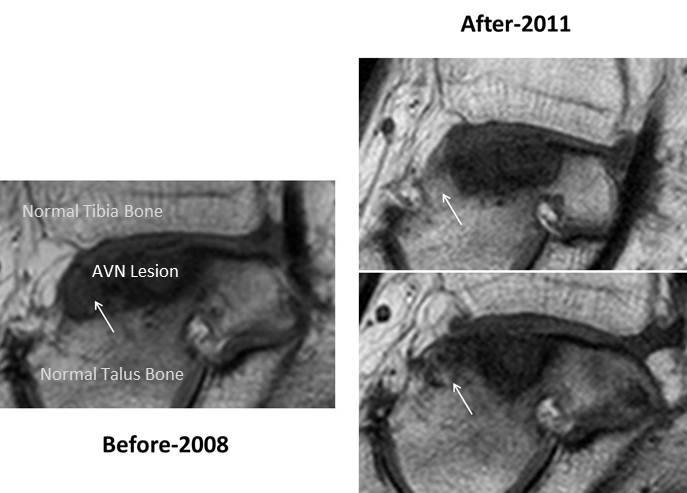Ankle AVN and Stem Cells: Only Halfway Toward the Finish Line
FB is a middle aged businessman who injured his ankle in a running related fall about 12 years ago. The ankle talus bone was fractured, so his doctors placed him into a cast. He saw many doctors as he had continued pain and then in 2006, he received the diagnosis of AVN of the ankle (also known as osteonecrosis). He was told he needed an ankle fusion. He was evaluated by our clinic in 2009, as serial MRI’s had shown no improvement in his condition and he wanted to avoid the ankle fusion. We debated at that time whether we should inject stem cells directly into the talus bone AVN lesion and risk fracturing this small bone or simply inject them into the ankle joint between the talus and the tibia. We ultimately chose the more conservative route and he underwent several ankle AVN stem cell Regenexx-C treatments where we injected his own stem cells into the tibio-talar ankle joint. I spoke to FB this week to review his MRI’s and decide on next steps, as from an outcome standpoint, he’s not yet to the finish line (some improvements, but not as much as we had hoped). His MRI images are above. On the left, his before sagittal T1 MRI shows a large dark area of AVN in the talus with the white arrow pointing to the front of that lesion. The problem with AVN bone lesions is that they tend to weaken the bone so much that it collapses. First the cartilage above the lesion goes, then the bone underneath caves in. Note that the same area of the white arrow in the 2011 after images (about 2 years after his first treatment) shows no dark area AVN lesion in the front of the ankle. This white arrow area is exactly where we were able to place most of the stem cells injected under x-ray guidance. However, as happy as we were to see that his AVN lesion was stable and getting smaller, we think we could have done better (similar to the results of stem cell injections we’ve seen in this patient’s AVN lesion in the knee), if we had placed the cells directly in the talus bone. The patient has a decision to make regarding additional bone related treatments. As in keeping with our clinic’s philosophy, we think it’s as important to discuss our successes as well those cases that only got halfway there, like FB. After all, understanding why you got only halfway to the finish line can hopefully help you figure out how to get the rest of the way home!

NOTE: This blog post provides general information to help the reader better understand regenerative medicine, musculoskeletal health, and related subjects. All content provided in this blog, website, or any linked materials, including text, graphics, images, patient profiles, outcomes, and information, are not intended and should not be considered or used as a substitute for medical advice, diagnosis, or treatment. Please always consult with a professional and certified healthcare provider to discuss if a treatment is right for you.

